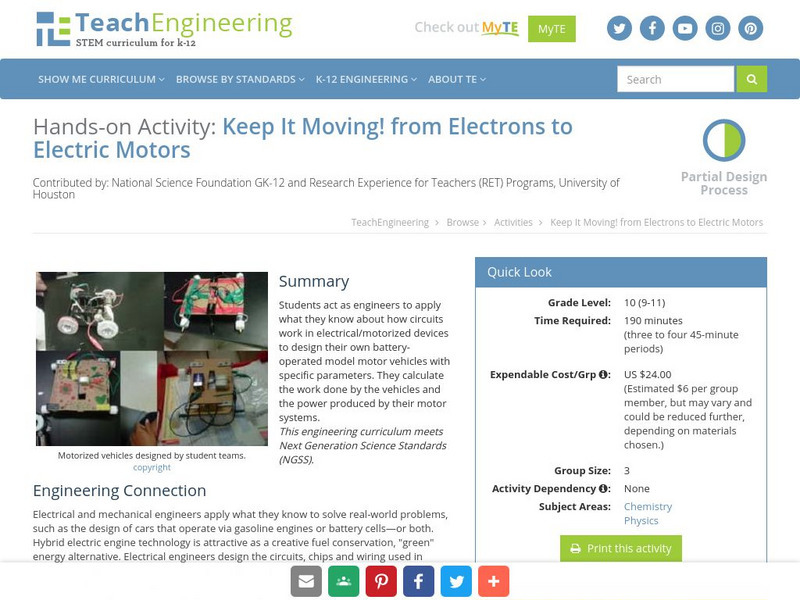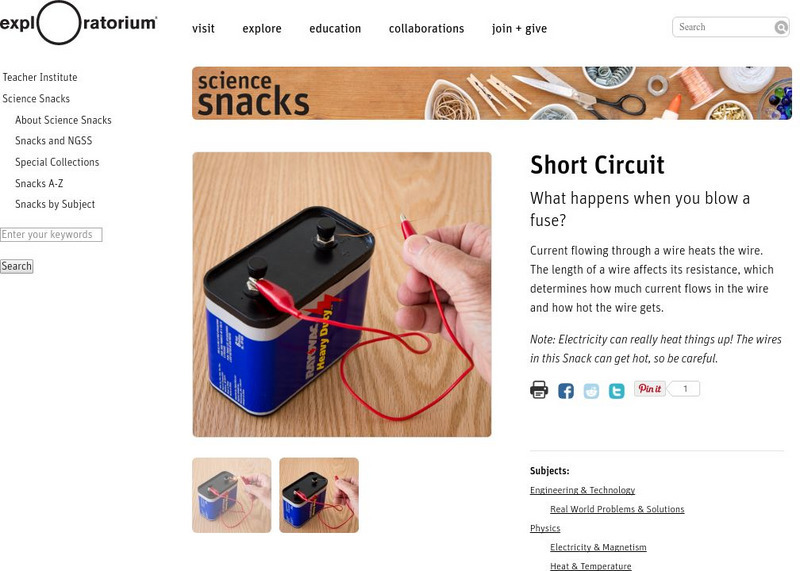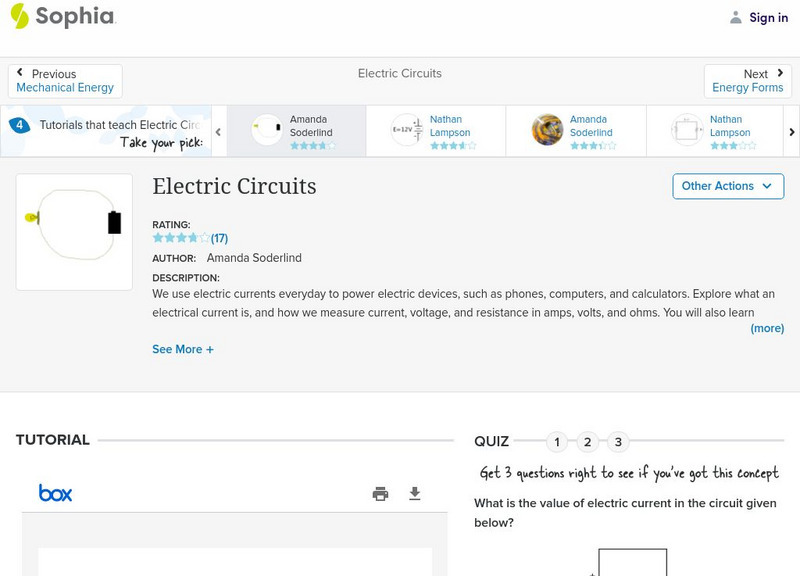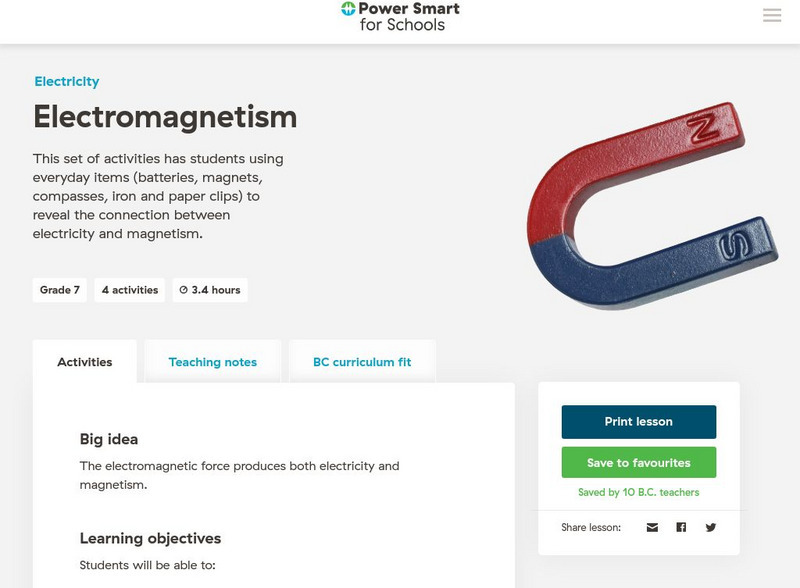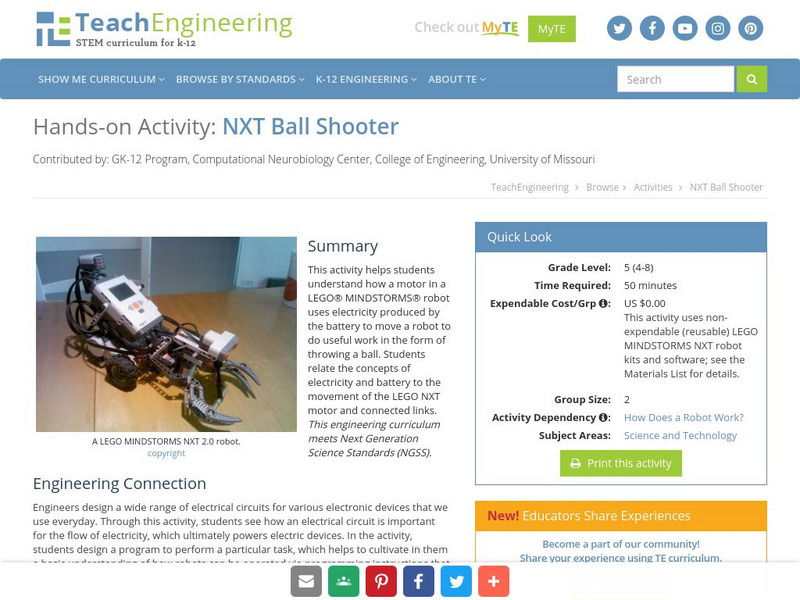TeachEngineering
Teach Engineering: Keep It Moving! From Electrons to Electric Motors
Students act as engineers to apply what they know about how circuits work in electrical/motorized devices to design their own battery-operated model motor vehicles with specific paramaters. They calculate the work done by the vehicles...
Exploratorium
Exploratorium: Science Snacks: Short Circuit
Learn how fuses and circuit breakers work to stop the flow of electricity in a circuit so as to prevent fires. This experiment requires caution.
eSchool Today
E School Today: Electricity
Explore current electricity and different types of electric circuits.
Other
Electricity: Simple Circuits
Create your own simple electric circuit. Using simple supplies build your own battery and investigate conductivity. You can also construct a crossword puzzle with electrical vocabulary words.
Utah State Office of Education
Utah Science: The Mysterious Force
There is a secret mysterious force in your home right this very moment! Try these activities to first identify that force and then extend your knowledge of the force by investigating the other activities provided.
Sophia Learning
Sophia: Electric Circuits: Lesson 3
This lesson will explain how to calculate voltage, current, and resistance in simple electric circuits. It is 3 of 4 in the series titled "Electric Circuits."
Massachusetts Institute of Technology
Mit: Open Course Ware: Introduction to Electronics, Signals, and Measurement
Online, college-level course on electronics. Class features the practical introduction to electronics with a focus on measurement and signals. Accessible components include downloadable lecture notes, assignments, and previous quiz and...
Science and Mathematics Initiative for Learning Enhancement (SMILE)
Smile: Electric Currents and Circuits
This cooperative learning activity for intermediate to junior high students has them create various electrical circuits in order to understand electricity.
University of Colorado
University of Colorado: Ph Et Interactive Simulations: Circuit Construction Kit (Ac+dc), Virtual Lab
With this interactive students will build circuits with capacitors, inductors, resistors and AC or DC voltage sources, and inspect them using lab instruments such as voltmeters and ammeters. Students will observe and discuss electricity...
University of Colorado
University of Colorado: Ph Et Interactive Simulations: Circuit Construction Kit (Dc Only), Virtual Lab
Build circuits with resistors, light bulbs, batteries, and switches and take measurements with laboratory equipment like the realistic ammeter and voltmeter.
Physics Classroom
The Physics Classroom: Current Electricity
Four complete lessons on current electricity in the study of physics. Lessons include informational text, interactive activities, animations, and quick, interactive comprehension checks.
Other
Bc Hydro: Power Smart for Schools: Electromagnetism
This set of activities has students using everyday items (batteries, magnets, compasses, iron and paper clips) to reveal the connection between electricity and magnetism. Ideally, students will already have experience building simple...
University of Colorado
University of Colorado: Ph Et Interactive Simulations: Circuit Construction Kit (Dc Only)
An electronics kit in your computer! Build circuits with resistors, light bulbs, batteries, and switches. Take measurements with the realistic ammeter and voltmeter. View the circuit as a schematic diagram, or switch to a life-like view....
University of Colorado
University of Colorado: Ph Et Interactive Simulations: Circuit Construction Kit (Ac+dc)
This new version of the CCK adds capacitors, inductors and AC voltage sources to your toolbox! Now you can graph the current and voltage as a function of time. Java required.
University of Colorado
University of Colorado: Ph Et Interactive Simulations: Signal Circuit
Why do the lights turn on in a room as soon as you flip a switch? Flip the switch and watch the electrons. Does the light turn on immediately? Explain using observations of the model.
TeachEngineering
Teach Engineering: How Does a Robot Work?
This lesson introduces electricity, batteries and motors using a LEGO MINDSTORMS NXT robot. The associated activity guides students to build a simple LEGO NXT set-up and see the practical implementation of the concepts discussed. Before...
TeachEngineering
Teach Engineering: Simple Coulter Counter
Students build and use a very basic Coulter electric sensing zone particle counter to count an unknown number of particles in a sample of "paint" to determine if enough particles per ml of paint exist to meet a quality standard. In a lab...
TeachEngineering
Teach Engineering: Nxt Ball Shooter
This activity helps students understand how a motor in a LEGO MINDSTORMS NXT robot uses electricity produced by the battery to move a robot to do useful work in the form of throwing a ball. Students relate the concepts of electricity and...
CK-12 Foundation
Ck 12: Physical Science: Electric Circuits
[Free Registration/Login may be required to access all resource tools.] Explains what an electric circuit is, its different parts, and how to represent it using a circuit diagram.
Physics Classroom
The Physics Classroom: Current Electricity: Circuit Connections: Series Circuits
When two or more electrical devices in a circuit can be connected, it is considered a series connection or a parallel connection. When all the devices are connected using series connections, the circuit is referred to as a series...
Physics Classroom
The Physics Classroom: Electric Circuits: Circuit Connections: Parallel Circuits
When two or more electrical devices in a circuit are connected, it is known as a series connection or a parallel connection. When all the devices are connected using parallel connections, the circuit is referred to as a parallel circuit....
Physics Classroom
The Physics Classroom: Electric Circuits: Circuit Builder
Students manipulate this virtual electronic circuit board where they can add resistors, light bulbs, wires, and ammeters to build a circuit, explore Ohm's law, and compare and contrast series, parallel, and combination circuits. Three...
Physics Classroom
The Physics Classroom: Electric Potential Difference
This tutorial is devoted to an understanding of electric potential difference and its application to the movement of charge in electric circuits. Take the interactive quiz to assess your understanding.
Physics Classroom
The Physics Classroom: Current Electricity: Electrical Resistance: Ohm's Law
There are certain formulas in physics that are so powerful and so pervasive that they reach the state of popular knowledge. The predominant equation which pervades the study of electric circuits is often referred to as the Ohm's law...
